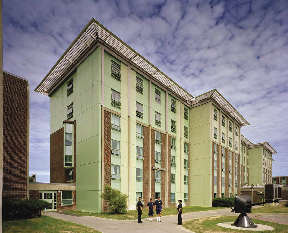Architect PCA, Inc., Erland Construction, the Massachusetts State College Building Authority, and the Massachusetts Maritime Academy were awarded a 2009 Building Team Award for the expansion and renovation of the school's energy-independent cadet residences. Completed in 2008, the 150-bed project is the first college residence hall in the state to be certified at the LEED Gold level by the US Green Building Council. It was honored by Building Design and Construction Magazine in the publication's 12th annual team awards issue in May.
In addition to utilizing energy produced on campus by rooftop solar panels, co-generation equipment and a campus wind turbine, the project offers a teachable model for teamwork on public projects. Developing a shared vision for sustainability, the design and construction team, The Mass. Maritime Academy, and the Mass. State College Building Authority collaborated to overcome challenging design and schedule obstacles throughout the project.
In addition to energy performance results including a "zero net energy" design that draws from on-campus renewable energy, the team succeeded in:
* Preserving the last open green space on the land-locked campus
* Creating an innovative structural solution allowing the construction of two new floors above a 1960s era residence hall, and
* Delivering a level of cost management and schedule control previously unheard of in public construction in Massachusetts, according to the client.
"I've always believed that client communication and teamwork produces the best architecture," said Steve Allen of PCA, principal in charge on the project, "and the results bear it out. At Mass. Maritime, working with expert partners who bought into the team concept from the start produced a residence hall that the Academy and its students can be proud of. We're thrilled with the results and grateful for the recognition.
About PCA: Prellwitz Chilinski Associates is a Cambridge-based architectural firm of 30 people who enjoy putting design into action on behalf of clients. Since 1982, PCA's thoughtful, award-winning design has generated one success after another. PCA projects thrive in the marketplace and bring lasting value to the community.
The Massachusetts Maritime Academy, founded in 1891 as the the Massachusetts Nautical Training School, is the nation's oldest maritime college.
The Massachusetts Maritime Academy is part of a seagoing tradition dating back to colonial times. The Academy's history as an educational institution began with an act of the State legislature, June 11, 1891, which created the Massachusetts Nautical Training School. The name was changed in 1913 to the Massachusetts Nautical School. From its founding until 1964, it was administered by a superintendent serving under a board of commissioners appointed by the Governor of the Commonwealth. The school has grown from an entering class of forty cadets in April, 1893, to a well respected, world recognized institution, the oldest maritime academy in continuous operation in the United States and the largest State maritime academy.
From its earliest days, the Academy had training vessels on loan from the Navy. The first training ship was the U.S.S. Enterprise, a full-rigged bark and steam powered cruiser, 185 feet in length, 35 feet in beam, drawing 14 feet, and having compound engines of 1200 horsepower. The Enterprise was replaced in 1909 by the U.S.S. Ranger, an iron gunboat, barkentine rigged, with steam engines. She was 177 feet long, with a 22 foot beam, and drew 14 feet. She had a wireless telegraph, submarine signal apparatus, a steam capstan, and steam steering gear-all very modern for the time. Ranger's name was changed to Nantucket in 1918 and she remained in Academy service until 1942, when federal responsibility for state maritime academies was transferred from the Navy to the United States Maritime Commission. Her last name was Emery Rice.
In 1942, the Massachusetts Nautical School moved from Boston to Hyannis. Given the new name of Massachusetts Maritime Academy, it was based at the former Hyannis State Teachers College campus. For most of World War II, the usual two-year course was shortened to sixteen months; new classes arrived as soon as space was available. As in World War I, Academy graduates served bravely and effectively.
During World War II, Maritime Academy cadets took their training cruises on a variety of merchant ships. At the war's end, the United States Maritime Commission reinstated the practice of providing training vessels to state maritime academies, and Massachusetts received the former Navy ship, U.S.S. Charleston, one of the last large gunboats. Built in 1936, she was 328 feet long, 41 feet in beam, and drew 13 feet. Oil fired boilers drove steam turbines developing 6,000 horsepower giving her a speed of up to 20 knots.
Acquiring a new Academy training ship meant a move from Hyannis in 1949, because Charleston's thirteen-foot draft was too much for Hyannis Harbor. The Maritime Academy's commissioners requested use of the State Pier at Buzzards Bay, where classrooms were made available. Berthing for the cadets was on the training ship. The Charleston was replaced by U.S.S. Doyen in 1957, renamed Bay State. She was a 415-foot-long, 60-foot-beam, 6,500-ton Navy attack transport with geared steam turbines (8500 h.p.) and a maximum of 18 knots.
In 1964, legislation placed Massachusetts Maritime Academy within the Division of State Colleges of the Commonwealth of Massachusetts. Also in that year, the Commonwealth of Massachusetts authorized the Academy to grant Bachelor of Science degrees in Marine Transportation and Marine Engineering to cadets completing a four-year course of study.
Initial accreditation as a college was granted by the New England Association of Schools and Colleges in 1974 and was renewed in 1980, 1990 and 2001.
In 1977, the Academy admitted women. Women currently comprise approximately 15% of the student population.
The training ship, Patriot State, formerly the Santa Mercedes, served the Academy from 1985 to 1999, and was replaced in 2000 by the present training ship, Kennedy, formerly the Cape Bon. Kennedy is 540 feet in length with a 76 foot beam, and she draws 27 feet. Her geared steam turbines of 15,500 shaft horsepower, produce a speed of 20 knots.
Since 1990, the Academy's programs have been expanded to include Facilities and Environmental Engineering, Marine Safety and Environmental Protection, and International Maritime Business, and Emergency Management.
Tags:
PCA, Inc. and Erland Const. win national award for Mass. Maritime Academy's energy-independent cadet residences
June 17, 2009 - Construction Design & Engineering
.png)








